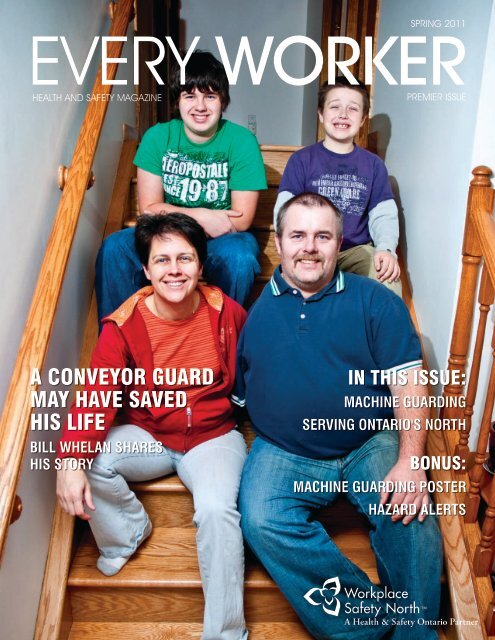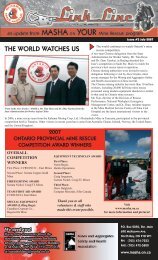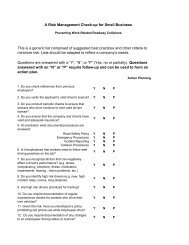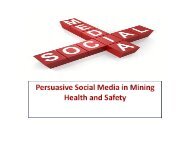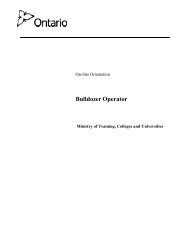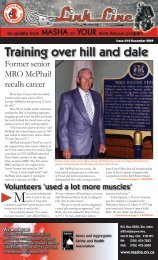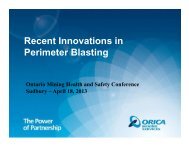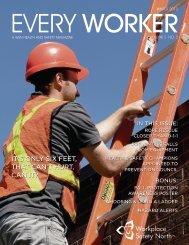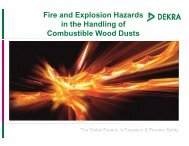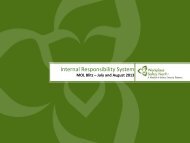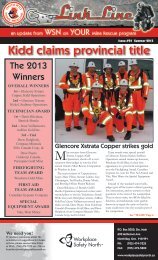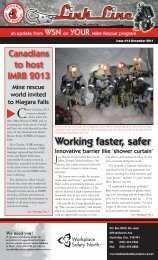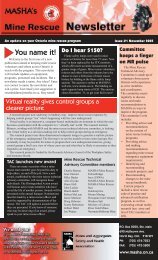a conveyor guard may have saved his life - Workplace Safety North
a conveyor guard may have saved his life - Workplace Safety North
a conveyor guard may have saved his life - Workplace Safety North
You also want an ePaper? Increase the reach of your titles
YUMPU automatically turns print PDFs into web optimized ePapers that Google loves.
SPRING 2011<br />
EVERY WORKER<br />
HEALTH AND SAFETY MAGAZINE PREMIER ISSUE<br />
A CONVEYOR GUARD<br />
MAY HAVE SAVED<br />
HIS LIFE<br />
BILL WHELAN SHARES<br />
HIS STORY<br />
IN THIS ISSUE:<br />
MACHINE GUARDING<br />
SERVING ONTARIO'S NORTH<br />
BONUS:<br />
MACHINE GUARDING POSTER<br />
HAZARD ALERTS
EVERY WORKER MAGAZINE SPRING 2011 VOLUME 1 NO. 1<br />
4<br />
A <strong>conveyor</strong> <strong>guard</strong> <strong>may</strong> <strong>have</strong><br />
<strong>saved</strong> <strong>his</strong> <strong>life</strong><br />
BY JOHN LEVESQUE<br />
2 www.healthandsafetyontario.ca<br />
FEATURES<br />
6 Beyond compliance: safe <strong>guard</strong>ing at<br />
Norampac<br />
BY KELLY ANN SMITH<br />
10 Expert panel calls for improvements to<br />
workplace safety system<br />
BY HEALTH AND SAFETY ONTARIO<br />
12 Research study tackles leading indicators<br />
BY INSTITUTE FOR WORK AND HEALTH<br />
14 Team work for a safer <strong>North</strong><br />
BY HEALTH AND SAFETY ONTARIO<br />
14 Hearst is leading the way<br />
BY JEAN BÉLEC<br />
PLUS...<br />
9 Paper, printing and converting sector hazard alert<br />
11 Mining sector hazard alert<br />
13 Forestry sector hazard alert<br />
Contents
President’s Message<br />
Welcome to Every Worker<br />
The magazine you’re holding in your hands,<br />
or reading on-line, is another milestone in<br />
<strong>Workplace</strong> <strong>Safety</strong> <strong>North</strong>’s development –<br />
it’s a tangible symbol of new beginnings and<br />
offerings from your new health and safety<br />
association.<br />
Last year we unveiled our new organization’s<br />
vision: Every worker, home safe and<br />
healthy, and t<strong>his</strong> magazine is one medium<br />
we’ll leverage to make t<strong>his</strong> vision a reality,<br />
through education and knowledge exchange.<br />
We believe our Every Worker vision is not<br />
only ours, but is shared by you and every<br />
conscientious employer and worker in the<br />
province. Fittingly, Every Worker magazine has been designed to provide<br />
WSN’s membership, and every worker who reads it, with access to vital health<br />
and safety information and tools to eliminate workplace illness, injury and<br />
death. It will connect every reader to perspectives and experiences from across<br />
the diverse sectors and communities we serve, with the goal of improving<br />
health and safety within every workplace.<br />
In t<strong>his</strong> issue we tackle machinery hazards from a number of angles. Did you<br />
know that between 2005 and 2009, 825 people in our sectors were either<br />
caught in or compressed by machinery, and were injured badly enough to need<br />
time off work? You’ll meet Bill Whelan who lost <strong>his</strong> arm in a <strong>conveyor</strong>, and<br />
you’ll learn the steps to dealing with <strong>guard</strong>ing hazards on your site.<br />
You can expect more great things from WSN down the road: the next issue of<br />
Every Worker will focus on another critical hazard: motor vehicle incidents<br />
and mobile equipment. You will see more exciting new products, enhanced<br />
access to the services you want and need, and unrivaled expertise. The best<br />
way to stay informed about new services and everything else that WSN can<br />
do for you is by subscribing to our free e-updates. To sign up, send a message<br />
with your name and email address to First2Know@workplacesafetynorth.ca.<br />
We hope you enjoy our inaugural issue of Every Worker. We put tremendous<br />
value on our member relationship, and we welcome your feedback. Drop me a<br />
line and let me know what you think about t<strong>his</strong> first issue.<br />
President & CEO<br />
candysballangermichaud@workplacesafetynorth.ca<br />
EVERY WORKER<br />
Home Safe and Healthy<br />
EDITOR<br />
Susan Haldane<br />
susanhaldane@workplacesafetynorth.ca<br />
CONTRIBUTORS<br />
John Levesque<br />
johnlevesque@workplacesafetynorth.ca<br />
Kelly Ann Smith<br />
kellyannsmith@workplacesafetynorth.ca<br />
Ken Sitter<br />
kensitter@workplacesafetynorth.ca<br />
PHOTOGRAPHY<br />
Neil Brown<br />
neilbrown@workplacesafetynorth.ca<br />
TRANSLATION<br />
Jean Bélec<br />
jeanbelec@workplacesafetynorth.ca<br />
DESIGN<br />
Brant Schewe<br />
brantschewe@workplacesafetynorth.ca<br />
PRINTED BY<br />
Creative Impressions<br />
www.creativeimpressions.ca<br />
For another copy of Every Worker or for<br />
the French version, call us<br />
Toll free: 1-888-730-7821(Ontario only)<br />
email: brantschewe@workplacesafetynorth.ca<br />
If you would like to receive t<strong>his</strong><br />
magazine electronically<br />
email: First2Know@workplacesafetynorth.ca<br />
WORKPLACE SAFETY NORTH<br />
690 McKeown Avenue, P.O. Box 2050,<br />
Stn. Main<br />
<strong>North</strong> Bay, ON P1B 9P1<br />
Toll free: 1-888-730-7821(Ontario only)<br />
Fax: 705 472 5800<br />
workplacesafetynorth.ca<br />
The information in t<strong>his</strong> publication is accurate to the best<br />
of our knowledge. WSN assumes no responsibility or<br />
liability for the accuracy or sufficiency of t<strong>his</strong> information,<br />
nor does it endorse any product mentioned herein with the<br />
exception of those produced by WSN.<br />
www.workplacesafetynorth.ca<br />
3
FEATURE<br />
4 www.healthandsafetyontario.ca<br />
A <strong>conveyor</strong> <strong>guard</strong> <strong>may</strong><br />
<strong>have</strong> <strong>saved</strong> <strong>his</strong> <strong>life</strong><br />
BY JOHN LEVESQUE, WORKPLACE SAFETY NORTH<br />
We know the victims of workplace incidents mainly as<br />
numbers. Every injury, from minor cuts and bruises to<br />
amputations and deaths, eventually joins the pool of statistics<br />
that make up WSIB injury claims, premium rates and general<br />
workplace injury trends.<br />
But very little is known about the people those numbers<br />
represent – the women and men, young and old, whose lives<br />
are changed by a workplace incident. The numbers don’t tell<br />
us what was going through their mind when they were injured<br />
or killed, or how it affected their family and friends. If they<br />
were permanently disabled, the numbers don’t tell us how they<br />
adjusted to <strong>life</strong> afterward.<br />
Meet Bill Whelan. He’s 31 years old, married to Tricia and father<br />
of a two-year-old son named Liam. It’s September 1999. Bill is<br />
doing a routine circuit check on the night shift at a Timmins<br />
mining company’s crushing plant. He happens to notice a piece<br />
of screening that’s tangled in the <strong>conveyor</strong> belt. As he always<br />
does when he sees that sort of thing, he reaches in to remove<br />
it. Except t<strong>his</strong> time the piece of screening is larger than he<br />
thought, part of it is hanging under the <strong>conveyor</strong>, it snares <strong>his</strong><br />
right hand, draws it along the belt into the pulley and tears off<br />
<strong>his</strong> arm at the shoulder.<br />
“By the time I realized it was happening it was over,” says Bill,<br />
now 42. “I had to make a decision then and there: Do I fight, or<br />
do I lay down and die.”<br />
Photo of Bill Whelan by Neil Brown
“You do things a certain way and eventually you<br />
forget there’s any danger involved. A lot of times<br />
I’ve asked myself what does it take to get the<br />
message through to people?"<br />
He decided to fight. He somehow got to <strong>his</strong> feet, reached inside<br />
<strong>his</strong> clothes to try to stop the bleeding and started walking back<br />
down the <strong>conveyor</strong> way for help. He managed to make it all<br />
the way to the mill, some 400 metres from the incident scene.<br />
“The first person I saw couldn’t handle it – he turned around<br />
and screamed and basically ran away from me. Shawn, the<br />
lead hand on our shift, was the one who started the first aid<br />
and got everything rolling.”<br />
Bill and Shawn were both volunteer firefighters – Bill in<br />
Timmins, Shawn in nearby Schumacher. As part of their<br />
firefighter duties they had taken a first responder’s course<br />
a month prior to the incident. “Shawn knew from the course<br />
that it was really important to stay calm,” Bill says. “He kept<br />
talking to me while we waited for the ambulance and that<br />
kept me calm.”<br />
Bill spent close to eight hours in surgery that night. Doctors<br />
tried to reattach <strong>his</strong> right arm, but <strong>his</strong> chest, back and neck<br />
were too badly mangled. When he awoke from the surgery<br />
he saw that <strong>his</strong> arm wasn’t there. The thought swirling in <strong>his</strong><br />
mind was: “What <strong>have</strong> I done to my family?”<br />
That first surgery was followed by six months of shuttling<br />
between Timmins and Toronto as doctors worked to rebuild<br />
Bill’s devastated right side. It was during t<strong>his</strong> period that Bill<br />
went into an emotional tailspin.<br />
“Once everything calmed down and I knew I was going to<br />
survive, I guess you could say the novelty wore off,” he says.<br />
“I was disabled. Everything I was used to doing I couldn’t do<br />
anymore. The hardest part for me was admitting to myself that<br />
I had made a big mistake that night. I really beat myself up for<br />
having done such a stupid thing.”<br />
Bill gets emotional when he talks about how <strong>his</strong> wife stood<br />
by him through the long period of physical and emotional<br />
recovery. “She was there for me when I hit bottom. She was<br />
there to see me through it all. The strength of my family and<br />
friends is what pulled me through. Even now if I <strong>have</strong> a hard<br />
day, my family is there for me.”<br />
Bill’s son Liam is 13 now, and <strong>his</strong> younger son, Tyler, is nine.<br />
The only dad they know is the one with a missing arm – the<br />
one who placed second in the above-elbow amputee category<br />
at the Canadian Amputee Golf Association National Open<br />
in London in the summer of 2009. “I’ve learned to be very<br />
stubborn,” Bill chuckles about <strong>his</strong> one-armed golfing prowess.<br />
“I shoot in the mid-80s all the time.” That same attitude has<br />
helped him in <strong>his</strong> overall adjustment. He hasn’t worn <strong>his</strong><br />
prosthetic arm for more than four years.<br />
Looking back on that September night in 1999, Bill is certain<br />
about one thing: If the <strong>guard</strong>s had not been on the <strong>conveyor</strong>,<br />
<strong>his</strong> entire upper body would <strong>have</strong> been pulled in, <strong>his</strong> head<br />
would <strong>have</strong> been crushed and he would <strong>have</strong> died instantly.<br />
Even with the <strong>guard</strong>s in place, if <strong>his</strong> left hand had been snared<br />
instead of <strong>his</strong> right, <strong>his</strong> heart would probably <strong>have</strong> been torn<br />
out of <strong>his</strong> chest.<br />
There was nothing exceptional about the mistake Bill made<br />
that night. He had been taking the same chances around the<br />
<strong>conveyor</strong> throughout the three and a half years he worked at<br />
the mining company. The odds simply caught up with him,<br />
and in a dangerous work environment even a small mistake<br />
can be lethal.<br />
The lesson Bill learned is a complicated one that continues<br />
to ripple through <strong>his</strong> <strong>life</strong>, but the message he wants to<br />
communicate is very simple: “Complacency kills,” he says.<br />
“You do things a certain way and eventually you forget there’s<br />
any danger involved. A lot of times I’ve asked myself what<br />
does it take to get the message through to people? Lock out the<br />
<strong>conveyor</strong>s before you work on them. Take a look first, because<br />
complacency kills.”<br />
These days Bill visits local high schools to talk to students about<br />
dangers in the workplace. He urges them to ask questions at<br />
work if they’re unsure about how to do something or if they<br />
think it might not be safe. His present job as a designer/<br />
draftsman at the Timmins office of J.L. Richards & Associate,<br />
an engineering firm with offices across Ontario, takes him to<br />
a lot of mine sites where he is sometimes asked to <strong>have</strong> a chat<br />
with the workers.<br />
“When they see me and I tell them about what happened to me,<br />
they pay attention,” Bill says. “I figure if I can reach out and get<br />
one person to stop and think – if I can prevent one person from<br />
going through what I went through – it’s worth all the effort.”<br />
www.workplacesafetynorth.ca<br />
5
Beyond compliance:<br />
safe <strong>guard</strong>ing at Norampac<br />
6 www.healthandsafetyontario.ca<br />
BY KELLY ANN SMITH, WORKPLACE SAFETY NORTH.<br />
What does it mean to be compliant<br />
with <strong>guard</strong>ing legislation? Simon<br />
Fridlyand, P. Eng. with S.A.F.E. Engineering<br />
in Toronto recommends looking to safety<br />
first. Compliance, he says, means the work<br />
process is “a safe process, which is compliant<br />
to current and applicable standards.”<br />
But how does a company make sure a work<br />
process complies with those standards?<br />
Marshall Greensides, Corporate Health<br />
and <strong>Safety</strong> Coordinator with Norampac,<br />
the largest producer of containerboard<br />
in Canada, says <strong>his</strong> company’s approach<br />
is to “identify the hazards, perform a risk<br />
analysis to prioritize A, B and C risks, define<br />
corrective measures and create an action<br />
plan, and then measure to make sure you’ve<br />
had the appropriate impact.” While legal<br />
Norampac employees packing boxes using a tilt table. Photo by Jerry Traer<br />
requirements are set out in the Occupational<br />
Health and <strong>Safety</strong> Act and the regulations,<br />
companies in Ontario <strong>have</strong> to determine how<br />
to apply those requirements. Greensides<br />
states “at Norampac, we believe that a risk<br />
assessment process involving workplace<br />
parties is critical to ensuring a better level of<br />
safety is achieved across the operations.”<br />
Norampac uses a seven-step process when<br />
dealing with a <strong>guard</strong>ing-related hazard.<br />
1. Identify the hazards using a companywide<br />
internal risk analysis.<br />
2. Once hazards <strong>have</strong> been identified, each<br />
Norampac plant must decide on which<br />
hazard has the highest potential for a<br />
severe consequence (an “A” risk), which<br />
is handled first. The safety facilitator or
champion within each facility involves<br />
maintenance people, supervisors and<br />
operators as well as joint health and safety<br />
committee members in finding solutions to<br />
the <strong>guard</strong>ing-related hazard.<br />
S.A.F.E. Engineer’s Fridlyand agrees that<br />
communicating with all the people who<br />
interact with the machine is very important.<br />
“Some people just put a box (around the<br />
hazard) and it’s absolutely safe, meets all<br />
the standards, no problem, but you cannot<br />
operate t<strong>his</strong> machine or t<strong>his</strong> machine<br />
becomes unproductive. And what happens?<br />
If t<strong>his</strong> is a production machine, and it<br />
hampers production, people remove <strong>guard</strong>s.”<br />
3. At Norampac, the next step is to call in a<br />
pre-qualified engineering firm to review the<br />
situation based on the internal risk analysis,<br />
production process, materials being used,<br />
lockout capabilities, equipment limitations,<br />
and the current mechanical or electrical<br />
<strong>guard</strong>ing systems of the machine.<br />
4. Norampac reviews the initial engineering<br />
report with the engineering firm to make sure<br />
all of the bases are covered. Out of that review,<br />
a final engineering report is created which<br />
is also reviewed by plant staff to make sure<br />
nothing was missed. Equipment efficiency<br />
is also a key component that needs to be<br />
addressed. The way in which plant personnel<br />
interact with the machine will change, so new<br />
safe work procedures must be developed. It is<br />
Marshall Greensides, Health and <strong>Safety</strong> Coordinator<br />
for Norampac, Mississauga<br />
also important to ensure new hazards <strong>have</strong><br />
not been created as a result of the changes.<br />
5. The next step is the secondary engineering<br />
review, t<strong>his</strong> time involving the company that<br />
will be installing the new <strong>guard</strong>ing system.<br />
Once the final design is confirmed with plant<br />
staff, including maintenance and operations,<br />
the new safety system is then installed.<br />
6. After installation, the machine is<br />
commissioned and the critical piece in<br />
the process happens: validation. Both<br />
operators and maintenance personnel are<br />
trained during t<strong>his</strong> step.<br />
“Then there’s a stage where we go live,”<br />
Greensides says. “At that point, typically<br />
the engineer is on site, the key person<br />
from the integration (installation) point<br />
of view is on site, and whoever the key<br />
project person is from the plant is on<br />
site.” The important question is: does<br />
the build match the design? “It’s like a<br />
design build check,” says Greensides,<br />
“and then they also test the functionality<br />
of each of the systems.” And over the next<br />
few weeks, the employees are watching<br />
the machine and reporting anything that<br />
seems off to their supervisor. Any changes<br />
or modifications that need to be made are<br />
done in consultation with the engineer.<br />
7. The last phase in the process is the final<br />
engineering review. T<strong>his</strong> is a report from<br />
the engineer, stating that the machine is<br />
now compliant with current and applicable<br />
standards. A copy of that report is then given<br />
to the joint health and safety committee and<br />
kept in a file in the plant.<br />
Greensides believes t<strong>his</strong> <strong>guard</strong>ing process,<br />
among many other initiatives to improve<br />
the safety and organization of the work<br />
environment, has paid off for Norampac,<br />
and has contributed to the decline<br />
in injuries. “We’ve seen a consistent<br />
reduction in our accident frequency over<br />
the last six years.”<br />
S.A.F.E. Engineering’s Simon Fridlyand<br />
can also attest to the benefits of making the<br />
investment in a <strong>guard</strong>ing program over the<br />
long term.<br />
“What’s absolutely important is to provide<br />
safe operation for all people and also to stay<br />
competitive and productive. And those two<br />
goals are easily achievable if you structure<br />
your process in a certain way. So you spend<br />
your money upgrading your equipment<br />
because you need to be compliant, and<br />
transfer liabilities. But if you do t<strong>his</strong> correctly,<br />
there is a payback and if there is a payback, it<br />
pays for all your efforts and continues paying<br />
on and on and on. The most important thing<br />
is that nobody gets hurt. But also because<br />
it’s a productive production machine, you<br />
manage to stay competitive.”<br />
Norampac and S.A.F.E. Engineering are not connected, and t<strong>his</strong> article does not indicate either firm’s<br />
endorsement of the other.<br />
"We’ve seen a consistent<br />
reduction in our accident<br />
frequency over the last<br />
six years.”<br />
www.workplacesafetynorth.ca<br />
7
KNOWLEDGE EXCHANGE<br />
Resources related to machine <strong>guard</strong>ing:<br />
1) Basic Machine <strong>Safety</strong> – Paper, Printing and Converting Certification Part 2<br />
T<strong>his</strong> half-day module is part of the suite of workplace-specific hazard training for pulp and<br />
paper operations. It provides certified members with the knowledge and skills to recognize,<br />
assess and control the most prevalent hazards in their workplaces.<br />
2) Machine Guarding in Forestry <strong>Workplace</strong>s<br />
T<strong>his</strong> half-day training program provides important information about recognizing, assessing<br />
and <strong>guard</strong>ing mechanical motion hazards that workers are exposed to when operating or<br />
conducting maintenance, repairs or troubleshooting on typical machines, equipment and<br />
work processes in forestry operations.<br />
Information<br />
- Safe Methods for Machine Guarding booklet – mining; Basic Machine <strong>Safety</strong> booklet<br />
– pulp and paper -- Visit http://www.workplacesafetynorth.ca/products.html.<br />
- CCOHS OSH Answers Conveyor <strong>Safety</strong><br />
http://www.ccohs.ca/oshanswers/safety_haz/<strong>conveyor</strong>_safety.html<br />
- Worksafe BC Machine Guarding checklist<br />
http://www2.worksafebc.com/PDFs/manufacturing/Safe<strong>guard</strong>ing_infoflip1.pdf<br />
- Worksafe BC Machine Safe<strong>guard</strong>ing Machinery and Equipment 100 page document<br />
http://www.worksafebc.ca/publications/health_and_safety/by_topic/assets/pdf/<br />
safe<strong>guard</strong>ing_machinery.pdf<br />
- OSHA Concepts and Techniques of Machine Safe<strong>guard</strong>ing<br />
http://www.osha.gov/Publications/Mach_SafeGuard/toc.html<br />
- NIOSH Machine <strong>Safety</strong><br />
http://www.cdc.gov/niosh/topics/machine/<br />
For more information regarding these and other <strong>Workplace</strong> <strong>Safety</strong> <strong>North</strong> programs or<br />
products call us toll free at 1-888-730-7821 or visit www.workplacesafetynorth.ca/training.<br />
Basic Machine <strong>Safety</strong><br />
Paper, Printing and Converting Sector<br />
www.workplacesafetynorth.ca<br />
8 www.healthandsafetyontario.ca<br />
Safe Methods for<br />
Machine Guarding<br />
Mining Sector<br />
www.workplacesafetynorth.ca<br />
MACHINERY: A<br />
CRITICAL WORKPLACE<br />
HAZARD<br />
In almost every type of workplace,<br />
workers are suffering serious<br />
injuries getting caught, squeezed,<br />
pinched, crushed and compressed<br />
by machinery. Machinery hazards<br />
are one of the top four sources of<br />
injury across Ontario, prompting a<br />
Ministry of Labour inspection blitz<br />
late in 2010.<br />
The forestry, mining, paper and<br />
printing industries are no exception:<br />
from 2005 to 2009 inclusive,<br />
<strong>Workplace</strong> <strong>Safety</strong> <strong>North</strong> clients<br />
reported 825 lost-time injuries<br />
due to workers being caught in<br />
or compressed by equipment or<br />
objects.<br />
Though printing equipment was<br />
involved in almost 18 per cent of<br />
all reported incidents, and paper<br />
production equipment almost 11<br />
per cent, the remaining 70 per cent<br />
involved a wide range of machinery<br />
in various sectors including mine<br />
drilling equipment, logging and<br />
wood processing equipment, both<br />
powered and gravity <strong>conveyor</strong>s,<br />
and stationary sawing equipment –<br />
none of which accounted for more<br />
than four per cent on their own.<br />
Of the workers involved in the<br />
incidents:<br />
- 17 per cent suffered an<br />
amputation<br />
- 25 per cent suffered a fracture<br />
- 20 per cent suffered cuts and<br />
lacerations<br />
- 15 per cent suffered bruises and<br />
contusions<br />
- 24 per cent suffered a range of<br />
injuries such as burns, sprains,<br />
strains, dislocations, etc. . .<br />
Proper machine <strong>guard</strong>ing and<br />
specific lockout procedures are key<br />
to preventing machinery-related<br />
incidents and injuries.
HAZARD ALERT!<br />
PAPER, PRINTING AND CONVERTING SECTOR<br />
Worker's foot crushed by lowering<br />
of winder table<br />
WHAT HAPPENED?<br />
A worker was preparing to tape a paper roll on the winder table. The table had<br />
been lowered to within six inches of the floor. After a few minutes, another<br />
worker standing at the control panel lowered the table all the way to the floor.<br />
The worker taping the roll had <strong>his</strong> foot positioned under the table. His foot was<br />
crushed between the table and floor, resulting in a fractured toe and removal<br />
of the toenail. The worker would <strong>have</strong> sustained more serious injuries had he<br />
not been wearing steel-toed safety boots, or had he positioned <strong>his</strong> foot further<br />
under the table.<br />
WHY DID IT HAPPEN?<br />
Holding the table slightly above the floor is common practice in the taping of small<br />
rolls. The practice relies on effective communication between operator and worker,<br />
and does not prevent unintentional lowering of the table to the floor.<br />
HOW COULD IT BE PREVENTED?<br />
One solution would be to install presence-sensing mats at points of operation (e.g.<br />
where the operator stands to tape the roll) or the addition of <strong>guard</strong>s to prevent the<br />
foot being placed under the suspended table.<br />
Paper production<br />
equipment accounts<br />
for close to 11%<br />
of contact with<br />
machinery injuries<br />
among WSN's clients<br />
(see page 8)<br />
call us toll free:1-888-730-7821 (Ontario only) www.workplacesafetynorth.ca<br />
T<strong>his</strong> alert is based on an actual incident. If you <strong>have</strong> an incident you’d like to share, please email info@workplacesafetynorth.ca. The description of<br />
circumstances does not reflect legal commentary, nor is it meant to assign legal responsibility to any person or firm.
Expert panel calls for improvements<br />
to workplace health and safety<br />
ARTICLE CONTRIBUTED BY HEALTH AND SAFETY ONTARIO<br />
On Thursday, December 16th, an Expert Advisory Panel on The recommendations include:<br />
Health and <strong>Safety</strong>, led by Tony Dean, released a series of<br />
- The establishment of a new prevention organization, housed in the<br />
recommendations which are being called the most substantial<br />
Ministry of Labour, and an associated council of stakeholders. The<br />
change to health and safety in Ontario since the Occupational<br />
health and safety associations would align with t<strong>his</strong> new entity.<br />
Health and <strong>Safety</strong> Act came into force in 1979.<br />
- A strong emphasis on training, including mandatory awareness<br />
Commissioned following the death of four workers who fell training for workers, supervisors, and health and safety<br />
from a swing stage in December 2009, the panel included representatives.<br />
representatives from government, industry and academia.<br />
- A special focus on high-risk work, vulnerable workers, and<br />
Over the course of its work, the panel asked a wide variety<br />
small business.<br />
of stakeholders for their views about how to improve the<br />
prevention system. The panel has now made substantial - New efforts to combat the underground economy.<br />
recommendations for improving both the structure of the - Tougher penalties for willful violators.<br />
system and its work. You can read the announcement as well<br />
as the full report at www.labour.gov.on.ca/english/hs/eap/<br />
The last of the 46 recommendations lays out the next steps for a<br />
report/index.php.<br />
smooth transition to a new prevention organization and health<br />
and safety requirements.<br />
“The recommendations support the work of <strong>Workplace</strong> <strong>Safety</strong><br />
<strong>North</strong> and its partners,” said WSN CEO Candys Ballanger-<br />
The Minister of Labour accepted the recommendations, and<br />
Michaud. “We welcome the release of the panel’s report, and<br />
pledged to begin work toward implementing them.<br />
we’re pleased that the announcement itself has raised public “We look forward to being part of t<strong>his</strong> new step forward for<br />
awareness about the need to enhance health and safety in Ontario’s workers and employers,” said Ballanger-Michaud. “As<br />
Ontario’s workplaces. We are encouraged by how the panel has t<strong>his</strong> transition takes place, our focus will be on continuing to deliver<br />
amplified the call to action to prevent workplace tragedies.” excellent health and safety service to our clients across the province.”<br />
“Take every precaution reasonable” to protect the health and safety of workers.<br />
DUE DILIGENCE AND IRS<br />
a supervisor's guide<br />
10 www.healthandsafetyontario.ca<br />
T<strong>his</strong> half-day program is designed as an orientation in the requirements of the Occupational<br />
Health and <strong>Safety</strong> Act and Regulations relating to management’s responsibility to “take<br />
every precaution reasonable” to protect the health and safety of workers. The course puts<br />
the concepts of due diligence and the internal responsibility system into practice as the<br />
core component of a company’s health and safety program.<br />
toll free: 1-888-730-7821 (Ontario only) web: www.workplacesafetynorth.ca<br />
call us toll free: 1-888-730-7821 (Ontario Only) www.workplacesafetynorth.ca
HAZARD ALERT!<br />
MINING SECTOR<br />
Removal of <strong>guard</strong> leads to pinch<br />
point injury<br />
WHAT HAPPENED?<br />
Two miners at an Ontario mine were installing ventilation tubing from the deck<br />
of a scissor lift being operated by a third miner at the controls. A hydraulic hose<br />
which passed through the deck of the lift was protected from damage by a cover<br />
made of angle-iron. The cover on t<strong>his</strong> particular machine did not pass all the way<br />
through the opening in the deck. With the deck in the down position, there was a<br />
space of several inches between the bottom edge of the angle-iron and the deck<br />
surface. When they were ready to start the installation, one of the miners on the<br />
deck instructed the operator to raise the deck. He didn’t realize the toe of <strong>his</strong> boot<br />
was in the space between the deck and the <strong>guard</strong>. As the deck began to rise, the<br />
miners’ toe was trapped and squeezed before they could reverse the deck and<br />
release <strong>his</strong> foot. Fortunately, the miner only received minor injury to <strong>his</strong> toes. The<br />
steel toe <strong>guard</strong> in <strong>his</strong> boot and the quick action of the lift operator in lowering the<br />
deck probably <strong>saved</strong> the worker from a much more serious injury.<br />
WHY DID IT HAPPEN?<br />
It was found that the <strong>guard</strong> had been removed to service the hydraulic line during a<br />
preventive maintenance overhaul of the scissor lift. Upon inspection of the scissor<br />
lift and as a result of the investigation, it was noted that the <strong>guard</strong> was shortened for<br />
reasons unknown. T<strong>his</strong> condition resulted in the creation of the pinch point hazard.<br />
HOW COULD IT BE PREVENTED?<br />
The company ordered inspections for all the rest of the scissor lifts but none were<br />
found to <strong>have</strong> the <strong>guard</strong> improperly installed. A new maintenance procedure was<br />
developed for removal and replacement of the hose <strong>guard</strong>.<br />
The steel toe <strong>guard</strong><br />
in <strong>his</strong> boot and the<br />
quick action of the lift<br />
operator... probably<br />
<strong>saved</strong> the worker<br />
from a much more<br />
serious injury.<br />
call us toll free:1-888-730-7821 (Ontario only) www.workplacesafetynorth.ca<br />
T<strong>his</strong> alert is based on an actual incident. If you <strong>have</strong> an incident you’d like to share, please email info@workplacesafetynorth.ca. The description of<br />
circumstances does not reflect legal commentary, nor is it meant to assign legal responsibility to any person or firm.
Research study tackles leading<br />
indicators<br />
BY ANITA DUBEY, INSTITUTE FOR WORK & HEALTH<br />
One of the largest workplace prevention studies ever undertaken<br />
in Ontario will be launched t<strong>his</strong> spring. Four health and safety<br />
associations are joining forces with the Institute for Work & Health, a<br />
research organization, to recruit 5,000 businesses to participate.<br />
The “5,000 Firm Study,” as it’s informally known, is focused on<br />
understanding how businesses’ health, safety and disability policies<br />
and practices are related to injuries and illness. The 5,000 firms<br />
will be randomly selected from the <strong>Workplace</strong> <strong>Safety</strong> and Insurance<br />
Board’s (WSIB’s) database. Some firms will initially be contacted by<br />
<strong>Workplace</strong> <strong>Safety</strong> <strong>North</strong>, while the others will be recruited by their<br />
respective associations.<br />
“T<strong>his</strong> is a groundbreaking project, which could potentially <strong>have</strong> huge<br />
implications for Ontario’s prevention system, and beyond,” says Dr.<br />
Ben Amick, IWH’s scientific director and the project lead. “A project<br />
of t<strong>his</strong> magnitude is only possible with the strong commitment to<br />
safety and support for research across Ontario’s prevention system.”<br />
In a web-based questionnaire, businesses will be asked questions<br />
about their safety culture, occupational health and safety management<br />
systems, joint health and safety committees, and organizational<br />
<strong>Workplace</strong> <strong>Safety</strong> <strong>North</strong><br />
ANNUAL GENERAL MEETING<br />
WEDNESDAY APRIL 20, 2011 2:00 p.m.<br />
12 www.healthandsafetyontario.ca<br />
policies and practices. T<strong>his</strong> survey will help to identify “leading<br />
organizational indicators.” A leading indicator provides a sense of an<br />
organization’s ongoing health and safety initiatives, and the potential<br />
for injuries or illnesses before they occur.<br />
Each firm’s responses about its management or organizational safety<br />
measures will be linked to its claim rate records – with all information<br />
being maintained in strict confidence by IWH. By making t<strong>his</strong> linkage,<br />
the researchers will be able to see if there are relationships between<br />
specific measures and injury or illness claims.<br />
At the end, the goal is to <strong>have</strong> a set of accurate leading indicators that<br />
all workplaces can use to assess their safety performance.<br />
Each participating firm will receive a report showing how it compares<br />
with other firms in its sector. Collectively, the information will create a<br />
huge knowledge base for Ontario, which can be used as a benchmark<br />
by any business.<br />
For more information about t<strong>his</strong> study, please contact Colette<br />
Severin, the project coordinator at IWH, at cseverin@iwh.on.ca or<br />
416 927-2027 ext. 2126.<br />
You are invited to WSN’s 1st Annual General Meeting. Mark your calendar and<br />
plan to attend. The meeting will take place during the Mining Health and <strong>Safety</strong><br />
Conference (see back cover for more information).<br />
Holiday Inn Hotel<br />
1696 Regent St.<br />
Sudbury, ON P3E 3Z8<br />
(705) 522-3000<br />
www.workplacesafetynorth.ca www.healthandsafetyontario.ca<br />
<strong>Workplace</strong> <strong>Safety</strong> <strong>North</strong><br />
690 McKeown Avenue<br />
<strong>North</strong> Bay, ON P1B 9P1<br />
TF: 1-888-730-7821<br />
F: 705-472-5800
HAZARD ALERT!<br />
FORESTRY SECTOR<br />
Vehicle carrying tree-thinning crew<br />
narrowly escapes collision with<br />
float truck<br />
WHAT HAPPENED?<br />
A tree-thinning crew was driving on a secondary logging road at the end of the day.<br />
It was wintertime, daylight was fading, 10 cm of fresh snow was on the ground and<br />
more was falling. The crew’s driver, who was on <strong>his</strong> first day in the cutting area, was<br />
not familiar with the road. His vehicle was travelling at about 40 km per hour.<br />
Without being aware of it, the driver reached an intersection with a primary logging<br />
road. A fast-moving truck suddenly came into view on <strong>his</strong> right. The driver braked<br />
hard as the float truck passed in front of him. His vehicle skidded into the intersection<br />
and narrowly missed the rear of the trailer. No one was injured.<br />
WHY DID IT HAPPEN?<br />
When the company inspected the incident site, it realized that there was no sign<br />
warning of the intersection. Because of the time of day, poor weather and the driver’s<br />
unfamiliarity with the route, it was difficult for him to know where the intersection<br />
was. Vegetation had grown in considerably on either side of the approach to the<br />
intersection, further hampering visibility. Another secondary road on the far side of<br />
the intersection made it look like the road continued beyond the intersection. Only<br />
the driver’s moderate speed prevented a devastating collision from happening.<br />
HOW COULD IT BE PREVENTED?<br />
Many serious incidents in forestry operations in recent years <strong>have</strong> involved collisions<br />
on logging roads. The sheer variety of types of vehicles used on these roads increases<br />
the hazards for everyone who drives on them. The condition of the roads further adds<br />
to the risk.<br />
Because of the seriousness of these hazards, Sections 114 to 119 of Regulation 851 for<br />
Industrial Establishments contain detailed requirements concerning logging roads<br />
and the vehicles that are driven on them. For example, Section 117(c)(ii) requires that<br />
all haul roads “<strong>have</strong> signs warning of the approach to every bridge, crossroad, blind<br />
curve, steep grade, and railway crossing”.<br />
Defensive driving practices are essential at all times on logging roads. Employers<br />
<strong>have</strong> a responsibility to ensure that logging roads are well-maintained, including the<br />
brushing of vegetation to improve sightlines. If a driver is unfamiliar with the road,<br />
special care needs to be taken, especially in bad weather and poor lighting. Two-way<br />
radios with which drivers communicate their position on logging roads are another<br />
important tool to prevent collisions.<br />
Defensive driving<br />
practices are<br />
essential at all times<br />
on logging roads.<br />
call us toll free:1-888-730-7821 (Ontario only) www.workplacesafetynorth.ca<br />
T<strong>his</strong> alert is based on an actual incident. If you <strong>have</strong> an incident you’d like to share, please email info@workplacesafetynorth.ca. The description of<br />
circumstances does not reflect legal commentary, nor is it meant to assign legal responsibility to any person or firm.
Teamwork for a safer <strong>North</strong><br />
ARTICLE CONTRIBUTED BY HEALTH AND SAFETY ONTARIO<br />
Starting in 2011, northern Ontario will benefit from improved<br />
coordination between the province’s four occupational<br />
health and safety associations.<br />
The benefits include<br />
- easier access to training and consulting services<br />
- more frequent training offered closer to your home<br />
- a larger pool of industry consultants available to help you<br />
- access to a variety of specialized, sector-specific and ergonomic<br />
resources<br />
- training and support from local experts who understand your<br />
part of Ontario.<br />
Working together to serve you<br />
A year ago, Ontario’s health and safety associations came<br />
together to form four leaner, more efficient associations: the<br />
Infrastructure Health & <strong>Safety</strong> Association (IHSA), the Public<br />
Services Health & <strong>Safety</strong> Association (PSHSA), <strong>Workplace</strong> <strong>Safety</strong><br />
<strong>North</strong> (WSN), and <strong>Workplace</strong> <strong>Safety</strong> & Prevention Services<br />
(WSPS). Together, these four groups make up Health & <strong>Safety</strong><br />
Ontario, your authoritative source of expertise on preventing<br />
injury and illness in your workplace.<br />
The purpose of t<strong>his</strong> change was to pool resources and avoid<br />
Hearst is leading the way<br />
BY JEAN BÉLEC, WORKPLACE SAFETY NORTH<br />
For Gilles Boisvert, WSN consultant-trainer in Hearst, the<br />
lines that define <strong>his</strong> district are no longer sector-specific but<br />
simply geographic. As early as 2009, through agreements entered<br />
with the former Ontario Service Sector Alliance, now falling under<br />
<strong>Workplace</strong> <strong>Safety</strong> and Prevention Services, Gilles started working<br />
with clients not traditionally served by him as a consultant-trainer<br />
with the former Ontario Forestry Safe <strong>Workplace</strong> Association.<br />
The traditional approach to serving an area like Hearst was for<br />
each health and safety association to focus solely on the firms<br />
that fall within the WSIB rate groups assigned to it, and for which<br />
it is funded. Since the restructuring of the 12 associations into<br />
four, each association’s clients <strong>have</strong> been able to benefit from<br />
the availability of what to them are new consultant-trainers. The<br />
newly formed associations <strong>have</strong> also reached agreements for<br />
a more seamless delivery of service. T<strong>his</strong> more flexible model<br />
allows WSN to benefit from the full spectrum of work experience<br />
possessed by its employees. Among other things, Gilles’<br />
knowledge and experience as a former business owner can now<br />
be leveraged in servicing WSN clients.<br />
In the Hearst area t<strong>his</strong> means that firms like financial institutions,<br />
14 www.healthandsafetyontario.ca<br />
duplication to give you more and better front-line service. That’s<br />
exactly what you’ll get from our new collaboration in the <strong>North</strong>.<br />
Right now, the health and safety associations <strong>have</strong> dozens of field<br />
consultants with diverse industry backgrounds and expertise<br />
working in the <strong>North</strong>. We can now make t<strong>his</strong> range of expertise<br />
available for the benefit of all industries in the <strong>North</strong>. As we<br />
collaborate, the health and safety associations will continue to<br />
operate as separate organizations. Serving our specific industries<br />
remains our priority. At the same time, you can look forward to<br />
these benefits of our teamwork.<br />
Benefits coming in 2011<br />
- Easier shopping for training: You’ll be able to view a joint training<br />
calendar on www.healthandsafetyontario.ca, and register for the<br />
four associations’ courses on www.workplacesafetynorth.ca.<br />
- A better <strong>Safety</strong> Group experience: In areas with large populations,<br />
such as Thunder Bay, Sault Ste. Marie, <strong>North</strong> Bay, Timmins,<br />
and Sudbury, several associations host <strong>Safety</strong> Groups.We will<br />
combine the meetings, resulting in greater opportunities for<br />
collaboration and networking. The <strong>Safety</strong> Groups themselves,<br />
however, will continue to operate as separate groups.<br />
- Partners in Prevention conferences and workshops in the<br />
<strong>North</strong>, with events in Thunder Bay, Timmins, <strong>North</strong> Bay,<br />
Sudbury, and Sault Ste. Marie.<br />
railway companies, social services agencies, motels, school boards,<br />
drilling companies, gas stations, hospitals, retail stores, pharmacies,<br />
pulp and paper companies, municipalities, car dealerships, the<br />
University of Hearst and even the Tim Hortons in Hearst are receiving<br />
health and safety consulting and training services from Gilles.<br />
Because of staffing issues, tight budgets and geographical<br />
challenges, the <strong>North</strong> as a whole has been under-serviced in the<br />
past. First contact with firms is sometimes awkward because of<br />
their lack of knowledge about the health and safety system. The<br />
new alignment has opened doors for Gilles and <strong>his</strong> colleagues<br />
in the <strong>North</strong> — a welcome change from the recent challenges<br />
the forest industry has been facing. By reaching a wider range<br />
of industries, the safety message is making its way through<br />
the community much faster. By communicating WSN’s safety<br />
message to a broader variety of firms, Gilles and <strong>his</strong> northern<br />
colleagues are becoming the go-to people for health and safety in<br />
their respective communities, which happens to be another long-<br />
term goal of the health and safety system realignment. There<br />
are still many obstacles to the system partners reaching a fully<br />
aligned delivery system, but we are on our way.
YOUR LIFE IS<br />
IN YOUR HANDS.<br />
GUARD IT.<br />
You might not be aware of the benefit of a machine <strong>guard</strong> until you come into contact<br />
with the moving parts of a machine that was supposed to be <strong>guard</strong>ed. But by then<br />
it’s too late. Occupational health and safety law in Ontario requires the <strong>guard</strong>ing of<br />
any mechanical motion that creates a hazard for workers. Make sure the equipment<br />
you’re working around is appropriately <strong>guard</strong>ed. If it isn’t, don’t approach it until it is.<br />
toll free: 1-888-730-7821 (Ontario only) web: www.workplacesafetynorth.ca www.workplacesafetynorth.ca<br />
15
Mining<br />
Health and <strong>Safety</strong> Conference<br />
2011<br />
April 19 -21, 2011 Sudbury ON<br />
CHANGING MINDS, CHANGING SAFETY<br />
Conference highlights:<br />
- Dr. Joe MacInnis – Deep Leadership: Lessons from Inside the Ocean – Dr. MacInnis has spent a<br />
<strong>life</strong>time exploring the dynamics of leadership and teamwork in lethal environments. He brings stories<br />
from deep-sea exploration including one of the first expeditions to the Titanic and work in the Gulf of<br />
Mexico following the Deepwater Horizon oil spill.<br />
- Dan Comiskey – <strong>Safety</strong> Leadership – Dan “The <strong>Safety</strong> Man” Comiskey learned about leadership and<br />
behaviour change in <strong>his</strong> 14 years playing in the CFL. But it was a close personal experience that made<br />
him dedicate <strong>his</strong> career to safety. Dan will discuss how to change our personal habits and beliefs.<br />
- John VanderDoelen – The New Shape of Health and <strong>Safety</strong> in Ontario – Following the release of the<br />
Tony Dean report late in 2010, John VanderDoelen is leading the transition for Ontario’s health and<br />
safety system.<br />
- Other topics: MSDs, <strong>guard</strong>ing, ground control, vehicle safety and more!<br />
For more information or to register, visit www.workplacesafetynorth.ca/conference2011<br />
16 www.healthandsafetyontario.ca<br />
toll free: 1-888-730-7821 (Ontario only) web: www.workplacesafetynorth.ca<br />
Platinum Sponsors Gold Sponsors Silver Sponsors


